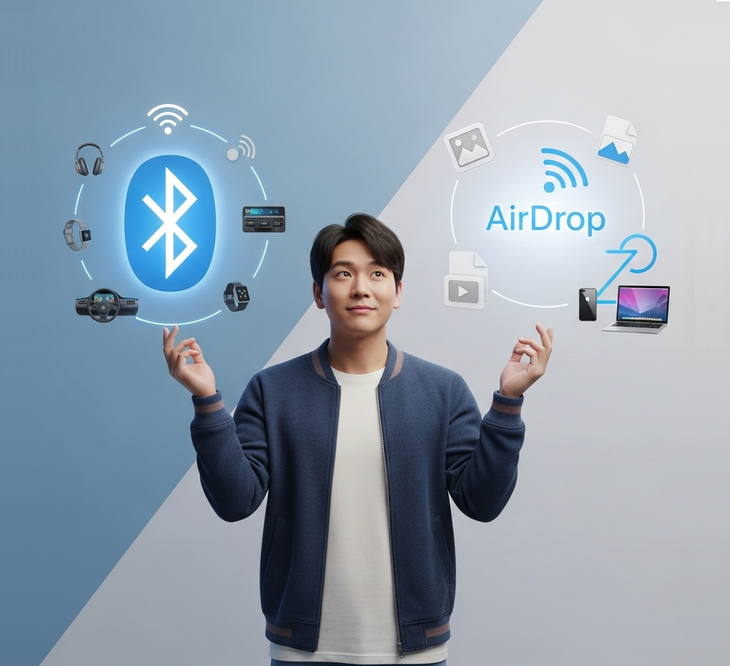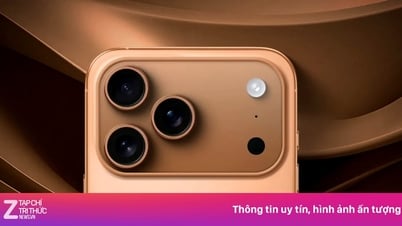
Users use both Bluetooth and Airdrop to serve their daily connectivity needs.
Both are wireless connections, both are available in the phone, but Bluetooth and AirDrop have two completely different approaches in terms of speed, range and convenience.
Many iPhone users are used to using both, but have never thought about how they are different and why they exist in parallel.
What is the difference between Bluetooth and AirDrop?
Bluetooth, which has been around since the late 1990s, quickly became the default technology on many personal electronic devices.
Bluetooth works by having two devices detect each other in close proximity, then pair and transmit data over radio waves. This process often requires manual confirmation from the user and can be time-consuming if the devices are not well-matched.
AirDrop is different. It’s Apple’s own feature that combines Bluetooth and WiFi to work. Bluetooth is used to scan for nearby devices, while WiFi is used to transfer data at high speeds.
Notably, AirDrop does not require a connection to any WiFi network. When needed, the iPhone can create a direct WiFi connection between two nearby Apple devices, called a peer-to-peer connection. Thanks to that, data is transferred much faster and more stable than pure Bluetooth.
The most obvious difference between the two technologies lies in their usage philosophy. Bluetooth was developed to operate flexibly in diverse device environments, regardless of platform.
AirDrop, on the other hand, is only for Apple devices, where data sharing is automated and packaged within a pre-synchronized system. Both are wireless sharing, but one prioritizes wide connectivity, the other focuses on simplifying the experience within a limited range.
When speed and convenience do not go together
In everyday life, Bluetooth is often used to connect to peripheral devices such as headphones, speakers, smart watches or car entertainment systems. These connections are established once, then automatically remembered and reactivated the next time they are used.
Bluetooth is also present on most electronic devices today, so users can use it immediately without worrying about the platform or manufacturer.
Meanwhile, AirDrop is suitable for situations where you need to quickly share between compatible devices that are close together, such as sending photos you just took, sharing files, or transferring links during a live chat. Users only need to perform a few simple steps to select recipients. However, this feature does not work if the receiving device is not part of the Apple ecosystem, and is sometimes limited if the privacy settings are not appropriate.
Neither technology is inherently better. Bluetooth is broad and well suited to communicating between different types of devices. AirDrop can save time in certain situations, provided the support conditions are met. Choosing the right solution allows users to move faster, rather than getting bogged down by misunderstanding the limitations of each technology.
Not a substitute, but a complement
In reality, Bluetooth and AirDrop don't compete directly, but rather exist as two complementary pieces of the user experience.
Bluetooth is responsible for long-term, cross-platform connectivity. It keeps your headphones connected to your phone, your smartwatch updated with notifications, and your car's devices synced with your phone regardless of the platform you're using.
AirDrop focuses on instant, instantaneous sharing, usually for just a few minutes. Without the need for pairing or establishing a permanent connection, AirDrop is a quick and easy way to send files between two people standing next to each other, as long as both are using compatible devices. Because of its “instant communication” nature, AirDrop is not intended to replace Bluetooth, but rather work alongside it to serve other needs.
The juxtaposition of these two technologies also reflects an important reality: not every new technology replaces the old. Despite coming later and being more convenient in some situations, AirDrop will not replace Bluetooth as a permanent, cross-platform, and universal connection.
And Bluetooth, while slower at sending data, is still a core part of many modern electronics. The two technologies exist not because they are the same, but because they serve completely different purposes.
Source: https://tuoitre.vn/bluetooth-va-airdrop-tuong-giong-hoa-ra-khong-20250703145821103.htm



![[Photo] General Secretary To Lam attends the opening ceremony of the National Achievements Exhibition](https://vphoto.vietnam.vn/thumb/1200x675/vietnam/resource/IMAGE/2025/8/28/d371751d37634474bb3d91c6f701be7f)
![[Photo] Politburo works with the Standing Committee of Cao Bang Provincial Party Committee and Hue City Party Committee](https://vphoto.vietnam.vn/thumb/1200x675/vietnam/resource/IMAGE/2025/8/28/fee8a847b1ff45188749eb0299c512b2)
![[Photo] Red flag with yellow star flutters in France on National Day September 2](https://vphoto.vietnam.vn/thumb/1200x675/vietnam/resource/IMAGE/2025/8/28/f6fc12215220488bb859230b86b9cc12)
![[Photo] General Secretary To Lam presents the 45-year Party membership badge to comrade Phan Dinh Trac](https://vphoto.vietnam.vn/thumb/1200x675/vietnam/resource/IMAGE/2025/8/28/e2f08c400e504e38ac694bc6142ac331)
![[Photo] Prime Minister Pham Minh Chinh meets with Speaker of the New Zealand Parliament Gerry Brownlee](https://vphoto.vietnam.vn/thumb/1200x675/vietnam/resource/IMAGE/2025/8/28/cec2630220ec49efbb04030e664995db)


































































































Comment (0)